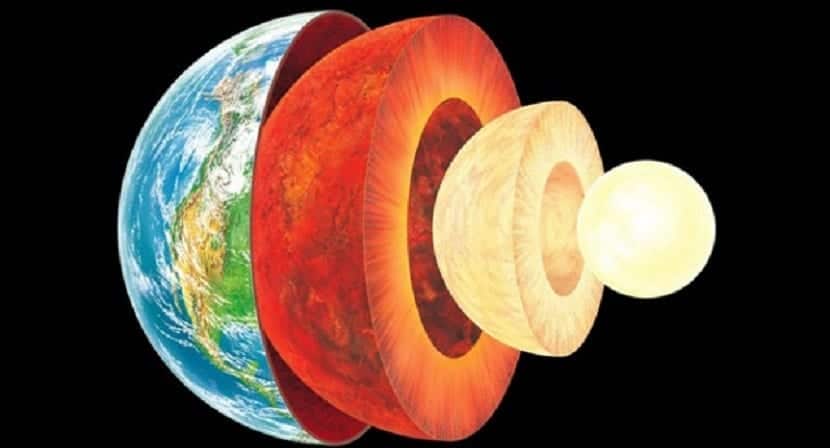
Now that we know the layers of the atmosphere, it's the turn at layers of the Earth. Since ancient times it has always been wanted to explain what we have below Earth's crust. Where do minerals come from? How many types of rocks are there? What layers does our planet have? There are many unknowns that have been generated throughout history and of which we want to know.
The part of Geology that studies the structure and the different layers of the Earth is the Internal Geodynamics. Our planet is made up of various types of elements that make life on Earth possible. These three elements are: Solids, liquids and gases. These elements are found in the different layers of the Earth.
There are many ways to classify the layers of the Earth. In one type of classification they are called spheres. These include the atmosphere, the hydrosphere, and the geosphere. It is the geosphere that collects all the structure and the different internal layers that our planet has. The layers are divided into two: The external and the internal. In our case, we are going to focus on the inner layers of the Earth, that is, the Earth's surface will be the beginning.
The layers of the earth
To begin to describe the layers of the Earth, we must make two differentiations. First, the criterion of the chemical composition of the different layers of the Earth is established. Considering the chemical composition, we find Earth's crust, mantle and core. It is the call Static model. The other criterion is taking into account the physical properties of said layers or also called a mechanical behavior model. Among them, we find the lithosphere, asthenosphere, mesosphere and endosphere.
But how do we know where a layer begins or ends? Scientists have found different methods to find out the type of material and the differentiation of layers by discontinuities. These discontinuities are areas of the inner layers of the Earth where the type of material that the layer is made of changes abruptly, that is, its chemical composition, or the state in which the elements are found (from solid to liquid).
First, we are going to start classifying the layers of the earth from the chemical model, that is, the layers of the Earth will be: Crust, mantle and core.
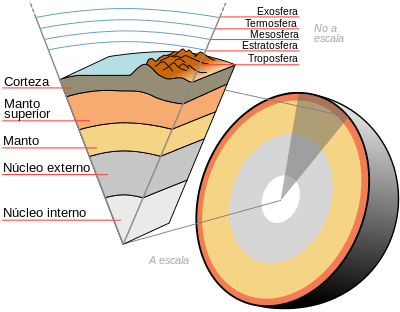
Layers of the Earth from the chemical composition model
Earth's crust
The Earth's crust is the most superficial layer of the Earth. It has an average density of 3 gr / cm3 and only contains 1,6% of all land volume. The earth's crust is divided into two large, well-differentiated areas: The continental crust and the oceanic crust.
The continental crust
The continental crust is thicker and has a more complex structure. It is also the oldest bark. It represents 40% of the Earth's surface. It is made up of a thin layer of sedimentary rocks, among which clays, sandstones and limestones stand out. They also have silica-rich plutonic igneous rocks similar to granite. As a curiosity, it is in the rocks of the continental crust that a large part of the geological events that have occurred throughout the history of the Earth have been recorded. This can be known since rocks have undergone many physical and chemical changes throughout history. For example, this is evident in the mountain ranges where we can find rocks of great antiquity that can reach up to l3.500 million years.
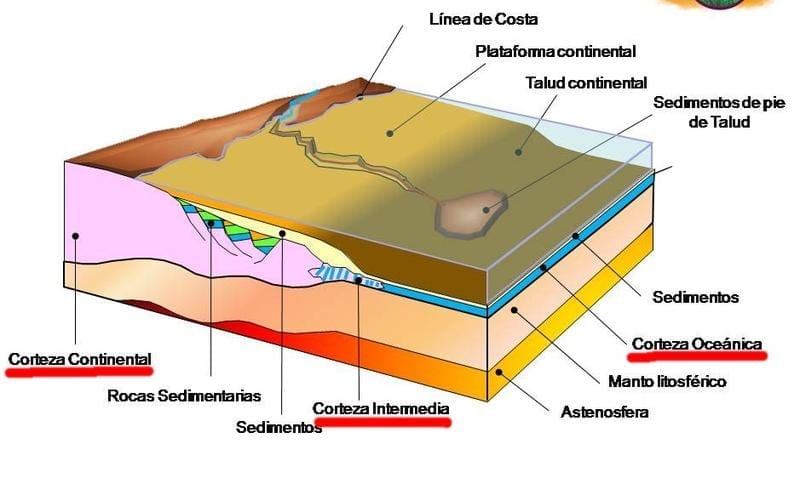
The oceanic crust
On the other hand, we have the oceanic crust. It has a lower thickness and a simpler structure. It is made up of two layers: a very thin layer of sediments and another layer with basalts (they are volcanic igneous rocks). This crust is younger because it has been shown that the basalts are continuously being formed and destroyed, so the rocks of the oceanic crust are older than they do not exceed 200 million years.
At the end of the earth's crust is the discontinuity of Mohorovicic (Mold). This discontinuity is what separates the earth's crust from the mantle. It is about 50 km deep.
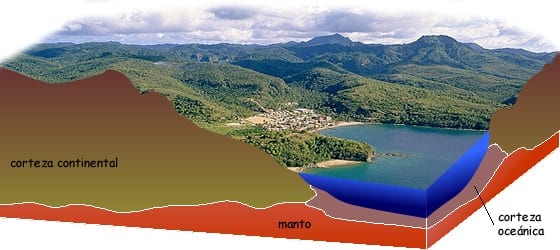
The oceanic crust is thinner than the continental
The Earth's mantle
The Earth's mantle is one of the parts of the Earth that extends from the base of the crust to the outer core. It begins just after the Moho discontinuity and is the largest layer on Earth. This is the 82% of all the terrestrial volume and 69% of all its mass. In the mantle you can distinguish, in turn, two layers separated by Repetti's secondary discontinuity. This discontinuity is about 800 km deep and is what separates the upper mantle from the lower one.
In the upper mantle we find the "Layer D". This layer is located more or less 200 km deep and is characterized by 5% or 10% of it is partially melted. This causes heat to rise from the core of the earth along the mantle. As the heat rises, the rocks of the mantle acquire a higher temperature and, at times, can rise to the surface and form volcanoes. These are called "Hot spots"

The composition of the mantle can be known by these tests:
- Meteorites of two types: The first are formed by peridotites and irons.
- Rocks existing on the earth's surface from the mantle that are removed to the outside due to tectonic movements.
- Volcanic chimneys: They are circular holes of great depth through which the magma rose and has revealed them. It can be 200 km long.
- Tests that shorten the seismic waves when they pass through the mantle that shows that there is a phase change. A phase change consists of modifications in the structure of minerals.
At the end of the earth's mantle we find Gutenberg discontinuity. This discontinuity separates the mantle from the earth's core and is located about 2.900 km deep.
The Earth's core
The Earth's core is the innermost area of the Earth. It extends from the Gutenberg discontinuity to the center of the Earth. It is a sphere that has a radius of 3.486 km, so it has a volume of 16% of the Earth's total. Its mass is 31% of the earth's total because it is made up of very dense materials.
In the core the Earth's magnetic field is generated due to the convection currents of the outer core that is melted around the inner core, which is solid. It has very high temperatures that are around 5000-6000 degree centigrade and pressures equivalent to one to three million atmosphere.
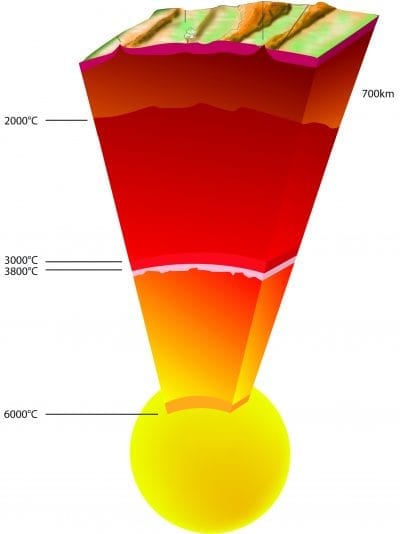
Temperature range at depth
The core of the Earth is divided into inner and outer core and the difference is given by secondary Wiechert discontinuity. The outer core ranges from 2.900 km deep to 5.100 km and is in a molten state. On the other hand, the inner core extends from the 5.100 km deep to the center of the Earth at about 6.000 km and is solid.
The earth's core is made up mainly of iron, with 5-10% nickel and a lower proportion of sulfur, silicon and oxygen. The tests that help to know the knowledge of the composition of the nucleus are:
- Very dense materials, for example. Due to their high density they stay in the inner core of the Earth.
- Iron meteorites.
- Iron shortage on the outside of the earth's crust, which tells us that iron must be concentrated inside.
- With the iron inside the nucleus, the Earth's magnetic field is formed.
This classification has been based on a model that takes into account the chemical composition of the different parts of the Earth and the elements that make up the layers of the Earth. Now we will know the division of the layers of the Earth from model a point of view of its mechanical behavior, that is, from its physical properties of the materials that compose it.
Parts of the earth according to the mechanical model
In this model, the layers of the Earth are divided into: Lithosphere, asthenosphere, mesosphere and endosphere.
Lithosphere
It is a rigid layer that has about 100 km thick that comprises from the crust and the most layer of the upper mantle. This rigid layer to the lithospheric layer that surrounds the Earth.
Asthenosphere
It is a plastic layer that corresponds to most of the upper mantle. In it exists convection currents and it is in constant motion. It has great importance in tectonics. This movement is caused by convection, that is, changes in the density of materials.
Mesosphere
It is located at depths of 660 km and 2.900 km. It is part of the lower mantle and part of the outer core of the Earth. Its end is given by the secondary discontinuity of Wiechert.
Endosphere
It comprises the inner core of the Earth described above.
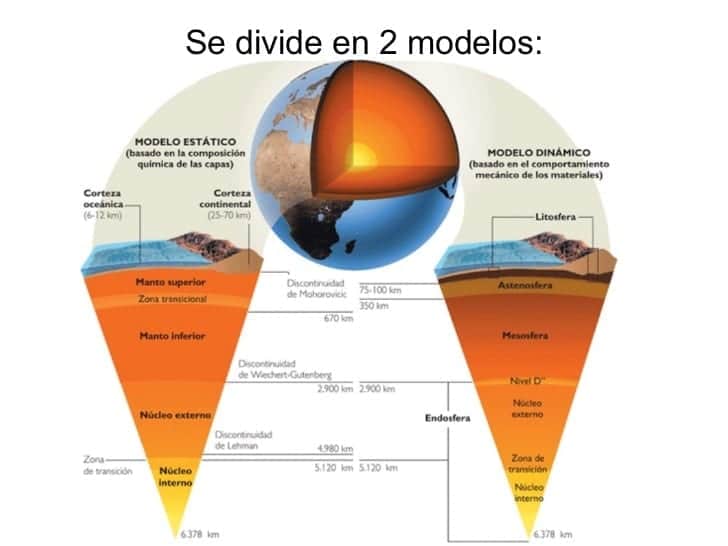
As you can see, scientists have been studying the interior of the Earth through various tests and evidences in order to know more and more about the planet on which we live. To make a comparison of how little we know about the interior of our planet, we only have to visualize the Earth as if it were an apple. Well, with all that we have advanced technologically, the deepest survey that has been achieved has been about 12 km deep. Comparing the planet to an apple, it's like we just peeled the final skin of the whole apple, where the seeds of the center would be equivalent to the terrestrial nucleus.

It's super cool, it's the text of the internal heart layers
Layer D¨ («double prime D layer») is not 200 kms DEPTH, but has approx. 200 kms of THICKNESS. There is info that works, but it is very general, and in several cases the lack of specification will confuse the reader.
DO NOT RELY ON THIS ARTICLE FOR ANY JOB OR JOB.